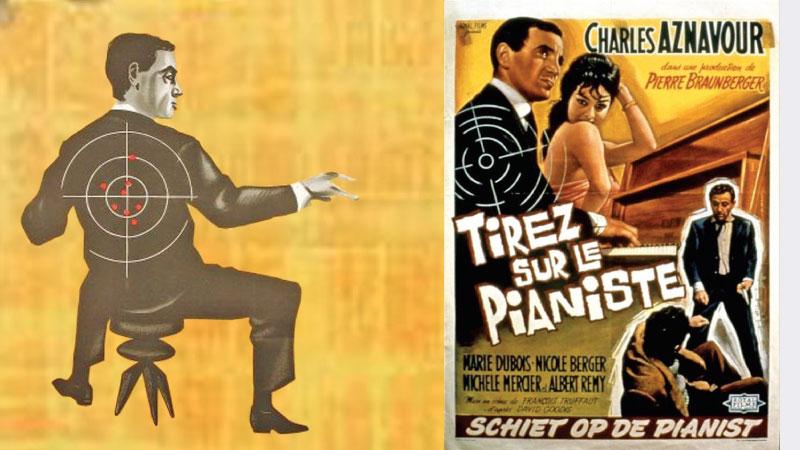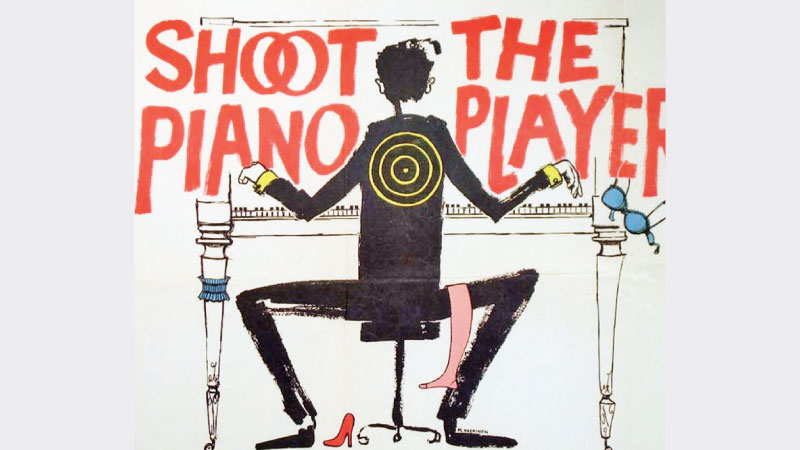
Synopsis:
Francois Truffaut’s loving homage to Hollywood gangster films is less a plot-filled film noir than a free-associative meditation on the genre. Charles Aznavour stars as a one-time concert pianist who gained fame as Edouard Saroyan but has since changed his name to Charlie Kohler and plays honky-tonk in an out-of-the-way saloon. His self-imposed exile is shattered by the appearance of his mobster brother Richard Saroyan (Jacques Aslanian). Richard and his other brother, Chico (Albert Remy), are on the lam from gangsters they have double-crossed. Charlie helps Richard and Chico get away, but he now finds that his life, along with his younger brother Fido’s (Richard Kanayan, has been put into jeopardy, having gotten mixed up with gangsters Momo (Claude Mansard) and Ernest (Daniel Boulanger) who are pursuing Richard and Chico. Momo and Ernest keep an eye on Charlie’s apartment and, although they don’t get Fido, they manage to kidnap Charlie and Lena (Marie Dubois), a co-worker with whom he has fallen in love. But when Ernest runs a red light and is pulled over, Charlie and Lena escape the gangsters’ clutches. They take refuge in Lena’s apartment, where Charlie sees a poster for a performance by Edouard Saroyan, causing Charlie to think back upon the circumstances that had led him to this moment in his life. Lena and Charlie make love, and Charlie returns to his apartment, only to discover Fido has been kidnapped. Lena and Charlie then head back to his club, where they plan to quit their jobs and try to find Fido.
 François Truffaut’s Shoot the Piano Player (1960) is one of those celebrated films that I had somehow just never seen until this weekend. Oh, I’d seen clips and knew a little about it—and I’d suspected that the phony gangster-movie opening of Ken Russell’s 1966 TV film on composer Georges Delerue, Don’t Shoot the Composer, was based on the Truffaut film (which it was), but I’d just never seen it. The experience was a sheer delight of the “Why hadn’t I seen this before?” variety. I loved everything about the film, but I can’t help but think that the blurb on the DVD case errs in calling it Truffaut’s “most playful film” without elaborating on that. It’s true, but more in terms of cinematically playful than in a literal sense. The film is a kind of a film-noir homage, but it’s rarely very serious about it and refuses to stay in a given genre. It’s a preposterous noir with a kind of art-film back story in the middle of it. It’s a comedy and a romance—and it always pretends to take itself seriously in each capacity.
François Truffaut’s Shoot the Piano Player (1960) is one of those celebrated films that I had somehow just never seen until this weekend. Oh, I’d seen clips and knew a little about it—and I’d suspected that the phony gangster-movie opening of Ken Russell’s 1966 TV film on composer Georges Delerue, Don’t Shoot the Composer, was based on the Truffaut film (which it was), but I’d just never seen it. The experience was a sheer delight of the “Why hadn’t I seen this before?” variety. I loved everything about the film, but I can’t help but think that the blurb on the DVD case errs in calling it Truffaut’s “most playful film” without elaborating on that. It’s true, but more in terms of cinematically playful than in a literal sense. The film is a kind of a film-noir homage, but it’s rarely very serious about it and refuses to stay in a given genre. It’s a preposterous noir with a kind of art-film back story in the middle of it. It’s a comedy and a romance—and it always pretends to take itself seriously in each capacity.
The story is built around Charlie Kohler (Charles Aznavour), the piano player in a bar that otherwise has nothing much going for it. He’s largely shut off from everyone and in his own little world—at least until his shiftless brother arrives bringing trouble in the form of a pair of not very menacing gangsters whom he has cheated in a robbery (though the gangsters’ ineptitude ultimately makes them dangerous). Charlie can’t help but become involved, because the gangsters insist on involving him—and by extension, the waitress, Lena (Marie Dubois), who is attracted to him.
Its ironic shifts of mood, from farce to near tragedy, conceal a deeper tone of despair. Charles Aznavour stars as a timid man, driven from society, who hurts when he tries to be kind and kills when he tries to love. Made with enthusiasm and audacity, it still seems fresh. What follows is a deliciously wild ride—and one of those rare movies that you’re sorry to see end.
